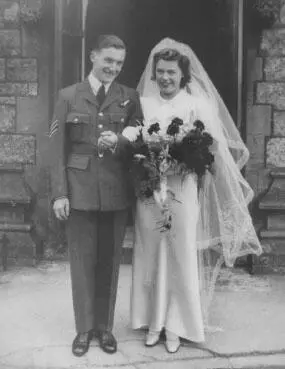However, the week before the wedding, McCarthy, now the proud holder of a DFC, called the crew together and told them that Wing Commander Guy Gibson had asked him to join a special squadron being formed for a single operation. His crew at once volunteered to go with him for that one trip. The first thing most of the aircrew noticed when they joined 617 Squadron was how experienced most of their fellows were – ‘lots of gongs on chests’ as Johnny Johnson recalls. ‘With all this experience, we were obviously up for something special.’ But he had ‘no idea what 617 Squadron was going to do,’ he says, ‘not a clue,’ but when he wrote to Gwyn and told her he was going on another op, he added, ‘Don’t worry, it’s just one trip. I’ll be there for the wedding.’
Her reply was brief and to the point: ‘If you’re not there on April the third, don’t bother.’
He thought that it would still be fine until they arrived at the new squadron’s base, Scampton, where one of the first things they were told was that there would be no leave for anyone until after the operation. However, McCarthy then marched his entire crew into Guy Gibson’s office and told him, ‘We’ve just finished our first tour; we’re entitled to a week’s leave. My bomb-aimer’s supposed to be getting married on the third of April and he’s gonna get married on the third of April.’
The patrician Guy Gibson didn’t like being told what to do by anyone, least of all an NCO, and an American to boot, but in the end he granted them four days’ leave and Johnson’s wedding went ahead. Wives of married aircrew weren’t allowed to live on base, but Gwyn, a military telephone operator, was posted to Hemswell, eight miles from Scampton, and she and Johnny could meet in Lincoln on their days or evenings off. The last buses for Hemswell and Scampton both left Lincoln at nine o’clock, and Johnson invariably ended up on the Hemswell bus and then had to walk the eight miles back to Scampton. ‘I was one of the few who had a wife close by,’ he says, ‘and it was important for me to get away from the squadron atmosphere to “normal” married life. We never talked about the war and certainly not about any fears or concerns for the future. Our time together was time away from the war.’ 3

Johnny and Gwyn Johnson on their wedding day
* * *
Johnny Johnson and the rest of Joe McCarthy’s crew were one of nineteen Lancaster crews from 617 Squadron, a total of 133 airmen, who set out for Germany on that ‘one special op’ on the evening of 16 May 1943. At 9.28 that evening, a few minutes before the sun set over the airfield, the runway controller at RAF Scampton flashed a green Aldis lamp. The four Merlin engines of the Lancaster bomber, already lined up on the grass runway, roared up to maximum power and the aircraft thundered into the sky. 617 Squadron was on its way to Germany, and though none of the participants knew it at the time, into the history books.
Two of the nineteen crews turned back even before reaching the enemy coast; one accidentally losing their bomb over the North Sea, another with a flak-damaged radio. Another Lancaster was lost altogether after its pilot, Flight Lieutenant Bill Astell, who like his peers was flying at extreme low level, flew straight into an electricity pylon, killing himself and his entire crew. Sixteen aircraft now remained.
617 Squadron’s leader, Wing Commander Guy Gibson, led the remainder of the first wave to their first target, the Möhne dam. Each crew would have to drop their bomb with total precision, flying at a speed of 232 mph, exactly 60 feet above the surface of the dam. There was no margin of error – dropped from too low an altitude, any water splash might damage the aircraft; too high and the bomb might simply sink or shatter. If dropped too far away, it could sink before reaching the dam; too close, and it might bounce over the parapet.
While the remainder circled at the eastern end of the lake, Gibson began his bomb-run, swooping down over the forested hillside and roaring across the water towards the dam, its twin towers deeper black outlines against the darkness of the night sky. The Upkeep bomb was already spinning at 500 rpm, sending juddering vibrations through the whole aircraft – ‘like driving on a cobbled road’ as one crewman described it. 4Gibson had just fourteen seconds to adjust his height, track and speed before the moment of bomb-release. Alerted by the thunder of the Lancaster’s engines, the German gun-crews of the flak batteries sited in the two towers of the dam scrambled to their battle stations and opened fire. Not a trace of breeze ruffled the surface of the black water, which was so still that it reflected the streams of tracer from the anti-aircraft guns like a mirror, leading Gibson and the pilots making the first bomb-runs to believe there were not three but six anti-aircraft guns firing at them.
At 0.28 on the morning of 17 May 1943 Guy Gibson’s bomb-aimer released his bomb. Gibson banked round in time to see the yellow flash beneath the surface of the water and subsequent waterspout, but as the water splashed down and the smoke dispersed, it was clear that his bomb had failed to breach the dam. He then circled and called in the next pilot, John ‘Hoppy’ Hopgood, nonchalantly describing the task as ‘a piece of cake’. It was anything but. Hopgood’s Lancaster had already been hit by flak as they flew across Germany towards the target, wounding several of his crew and giving him a serious facial wound, but he flew on, pressing a handkerchief against the wound to staunch the flow of blood. Turning to evade the probing searchlight beams, he flew so low that he even passed beneath the high-tension cables of a power line stretching across a landscape as dark as the night sky above them.
As he made his bomb-run, Hopgood’s aircraft was again hit by flak and burst into flames. Although his bomb was released, it was dropped too close and bounced clean over the dam wall. Although it destroyed the electricity power station at its foot, sending a column of thick, black smoke high into the air, it did no damage to the dam itself. Hopgood managed to coax his stricken and burning aircraft up to 500 feet, giving his crew a slim chance of survival, but as he shouted ‘For Christ’s sake, get out!’ 5the flames reached the main wing fuel tank, which exploded. Two crewmen did manage to bale out, and survived, to see out the war as PoWs. His badly wounded wireless operator also baled out, but his parachute did not open in time. Hopgood and the other three members of his crew were trapped in the aircraft as it crashed in flames, and all were killed instantly.
The twenty-five-year-old Australian pilot Harold ‘Mick’ Martin was next to make a bomb-run, with Gibson now bravely flying almost alongside him to distract the flak gunners and draw their fire. Martin’s bomb was released successfully, but two flak shells had struck a petrol tank in his starboard wing and, though it was empty of fuel and there was no explosion, the impact may have thrown their bomb off course. As Martin flew on between the stone towers of the dam, the bomb hit the water at an angle and bounced away to the left side of the dam, before detonating in the mud at the water’s edge. However, the force of the mud and water thrown up by the blast dislodged one of the flak guns on the southern tower from its mounting and the gun-crew of the battery in the northern tower were now also forced to change their red-hot gun-barrels.
In the lull in the firing, Melvin ‘Dinghy’ Young – so named after surviving two ditchings at sea – made his bomb-run. His Upkeep was released perfectly, bouncing in smooth parabolas along the surface of the water. It struck the exact centre of the dam and sank deep below the surface before detonating against the dam wall. The explosion sent up another huge waterspout, but once more it appeared to have failed to breach the dam.
Читать дальше













